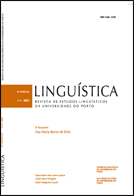Demonstratives, definiteness effects and the type-token distinction
Resumo
Definiteness effects have been attested in the literature for some DPs complementing HAVE (= English have and their counterparts in other languages). In this paper, which focuses on English and Spanish, demonstrative DPs are shown to be affected by the type-token distinction in HAVE contexts: the internal argument of HAVE receives a type reading in these cases and rejects a token interpretation. The “type restriction on demonstrative DPs” (TRD) is shown to follow from the need for narrow focus NPs complementing HAVE to receive a hearer-new reading, a well-known property of presentational structures. Type readings of demonstrative DPs are shown to meet this condition. Apparent exceptions to the TRD effect include (i) DPs in so-called “remainder contexts”; (ii) structures in which the relevant DP is the subject of a small clause (sometimes with a non-overt predicate); and (iii) structures containing a number of anti-assertive operators. The contexts in (i) are shown to be hearer-new, in spite of being definite. Those in (ii) and (iii) provide DPs which escape the narrow focus interpretation that gives ride to this variety of the definiteness effect.
Referências
Abbot. B. 1993. A Pragmatic Account of the Definiteness Effect in Existential Sentences. Journal of Pragmatics. 19: 39-55.
Bassaganyas-Bars. T. 2017. Have-Sentences in Discourse. Doctoral Dissertation. Barcelona, Universitat Pompeu Fabra. Available online.
Bassaganyas-Bars. T. & McNally, L. 2020. There be- and have-Sentences: Different Semantics, Different Definiteness Effects”. The Linguistic Review. 37(2): 179-208.
Benveniste E. 1960. Être et avoir dans leurs fonctions linguistiques. Bulletin de la Société de Linguistique de Paris. 55: 113-134. Reprinted in Problèmes de linguistique générale, Paris, Minuit, 187-207.
Bosque, I. 2010. On Disjunctive Dependencies. Catalan Journal of Linguistics. 9: 7-21.
Bosque, I. & Sáez, L. A. 2017. La naturaleza composicional de tan(to) y los contextos antiasertivos. In Á. J. Gallego et al. (Eds.). Relaciones sintácticas: Homenaje a José M. Brucart y M. Lluïsa Hernanz. Barcelona: Universitat Autònoma de Barcelona, 121-140.
Español-Echevarría, M. 1997. Inalienable Possession in Copulative Contexts. Lingua 101: 211-244.
Fischer, S. et al. (eds.). 2016. Definiteness Effects: Bilingual, Typological and Diachronic Variation. Cambridge: Cambridge Scholar Publishing.
Freeze, R. 1992. Existentials and other Locatives. Language. 68 (3): 553-595.
Guéron, J. & Zribi-Hertz, A. 1998. La grammaire de la possession. Nanterre: Paris X.
Gutiérrez-Rexach, J. 2000. Tener y el efecto de definitud. Cuadernos de lingüística (Instituto Ortega y Gasset). 7: 19-37.
Gutiérrez-Rexach, J. 2007. Beyond the (In)definiteness Restriction: a Unified Semantics for have. In E. Puig-Waldmüller (Ed.). Proceedings of Sinn und Bedeutung 11. Barcelona: Universitat Pompeu Fabra, 91-304.
Hannay, M. 1985. English Existentials in Functional Grammar. Dordrecht: Foris.
Heine, B. 1997. Possession: Cognitive Sources, Forces and Grammaticalization. Cambridge: Cambridge University Press.
Hornstein, N., Rosen, S. and Uriagereka, J. 1996. Integral Predication. Proceedings of WCCFL. 14: 169-184.
Kayne, R. S. 1993. Toward a Modular Theory of Auxiliary Selection. Studia Linguistica. 47 (1): 3-31.
Keenan, E. 1987. A Semantic Definition of Indefinite NP. In A. Reuland & A. G. B. ter Meulen (Eds.). The representation of (in)definiteness. Cambridge, MA: The MIT Press, 286-317.
Kupferman, L. 2000. Avoir et la prédication seconde. Langue Française. 127: 67-111.
Landman, F. 2004. Indefinites and the Type of Sets. Oxford: Blackwell.
Leonetti, M. 1999. El artículo. In I. Bosque & V. Demonte (Eds.). Gramática descriptiva de la lengua española. Madrid: Espasa, vol. 1, 787-890.
Leonetti. M. 2006. Sobre la restricción de definitud con tener. Paper presented at the VII Congreso de Lingüística General. Barcelona: Universidad de Barcelona.
Leonetti. M. 2016. Definiteness Effects: The Interplay of Information Structure and Pragmatics. In Fischer, S. et al. (eds.), 65-116.
Lumsden, M. 1988. Existential Sentences: Their Structure and Meaning. London: Croom Helm.
Lyons, C. 1999. Definiteness. Cambridge: Cambridge University Press.
McNally, L. 2016. Existential Sentences Cross-Linguistically: Variations in Form and Meaning. Annual Review of Linguistics. 2: 211-231.
RAE-ASALE, 2009. Real Academia Española y Asociación de Academias de la Lengua Española: Nueva gramática de la lengua española. Morfología y sintaxis. Madrid: Espasa, 2 vols.
Rando, E. & Napoli, D. J. 1978. Definites in There-Sentences. Language. 54(2): 300-313.
Reuland, E. & ter Meulen, A. G. B. (Eds.). 1987. The Representation of (In)definiteness. Cambridge, MA: The MIT Press.
Stassen, L. 2009. Predicative Possession. Oxford: Oxford University Press.
Szabolcsi, A. 1983. The Possessor that Ran Away from Home. The Linguistic Review. 3: 89-102.
Tham, S. W. 2006. The Definiteness Effect in English Have Sentences. In P. Denis et al. (Eds.). Proceedings of the 8th Texas Linguistic Conference. Somerville: Cascadilla Proceedings Project, 137-149.
Uriagereka, J. 1998. From Being to Having: Questions about Ontology from a Kayne/Szabolcsi Syntax. In A. Schwgler et al. (Eds.). Romance Linguistics. Theoretical Perspectives. Amsterdam: John Benajamins, 283-306.
Ward. G. & Birner. B. 1995. Definiteness and the English Existential. Language. 71(4): 722-742.
Woisetschlaeger, E. 1983. On the Question of Definiteness in ‘An Old Man’s Book. Linguistic Inquiry. 14: 137-154.
Downloads
Publicado
Edição
Secção
Licença
Direitos de Autor (c) 2021 Linguística: Revista de Estudos Linguísticos da Universidade do Porto

Este trabalho encontra-se publicado com a Creative Commons Atribuição-NãoComercial 4.0.



